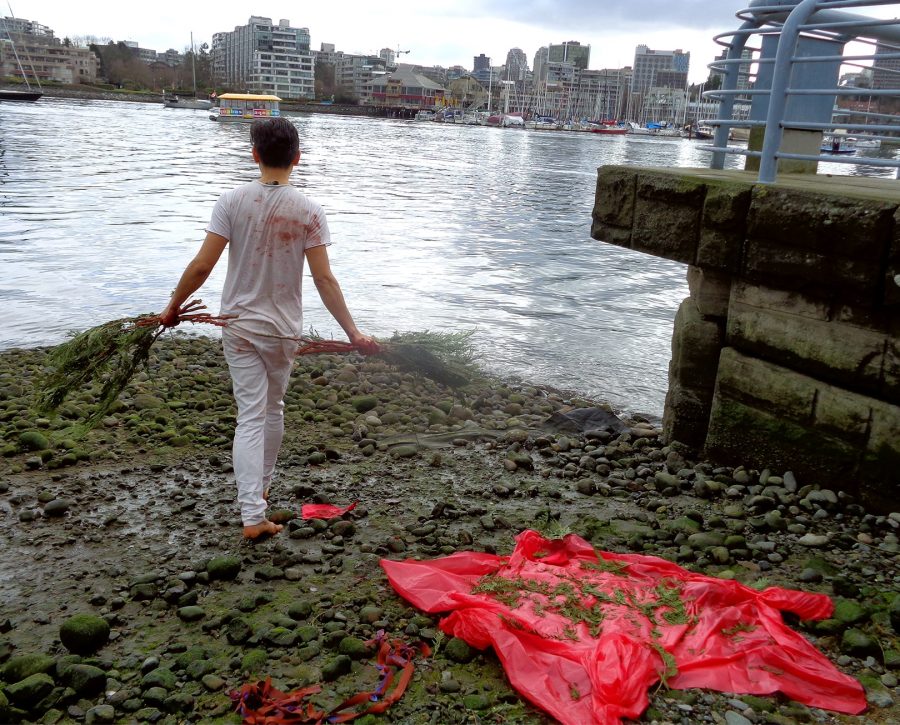This piece originally appeared in Issue 3.42 (Fall 2020).
Manuel Axel Strain: Needed Medicine was on view from January 10 – February 15, 2020 at Gallery Gachet in Vancouver.

The exhibition opens with a performance. The artist Manuel Axel Strain passes around cards with instructions for audience members before momentarily disappearing. A section of Blood Alley cobblestone is vigorously scrubbed clean by Stephanie Gagne, who performs as a token white girl. We are instructed to text the exhibition title and a reply appears in the form of excerpts from racist online trolls. I respond with 💔.
Strain reemerges dressed in white, clean-cut with perfectly sculpted hair and eyebrows. They apply a mixture of smudge ash, clay, and tumuth to their face, pressing it against the washed cobblestone. They methodically repeat this action before laying on the wet ground, outstretched. Strain’s niece and others raise them up while audience members are invited to smudge. Strain names family members and ancestors before expressing an inability to feel the land — their ancestral land — then exits the alley.
Inside Needed Medicine, cedar branches rest on a table: a poised docent gesturing towards the main gallery. There are works in sculpture, video, body prints, and a mixed-media portrait. In the dual-channel video installation, people introduce themselves on the right. They name origins and where they live, closing with “hay chxw q’a.”
A close-up of the artist’s mouth projects on the adjoining wall, translating the introductions with muted audio. One interview subject names ancestry traced to John A. Macdonald, while another names place-based origins as outer space followed by “hay chxw q’a” with fluent ease. The gaze of the artist is present although we only see their mouth in silent translation. Strategic humour emerges in the juxtaposition of different interview clips and in the form of subtle expressions on Strain’s face. The dual-channel install becomes a panorama in the form of a mirror-projected vista with a delay between projections.
The portraits and sculptures in the show ensnare me in the act of witnessing. The materials as autobiographic ephemera illuminate the hard and soft edges of who Needed Medicine is for and call into question what it means to be witnessed and by whom? Disparate healing traditions bound by colonialities are often pitted against one another, but in the show, they are situated in a dialogical approach to healing by juxtaposing the materials in single pieces. There is a medicine-wheel-cum-celtic-
After the opening buzz, I stop by the show sometimes just to stand in the middle. I think, “Here I am for you, show. Your steadfast admirer.” I imagine our unmediated separateness and the sentience of the work. The art returns my gaze and we share a moment, nonplussed by the objectifying locus of the yt gayz.
In the closing performance, the artist bundles, ties, and carries the cedar from the exhibition entrance to the harbour with a few of us trailing behind, chatty and reverent. The cedar branches are bundled in red material and tied to Strain’s biceps with blue stretch tourniquet. They climb down a low stone wall through some trees to stand by the water’s edge. The artist unbundles the cedar and two otters swim by. Strain speaks, then they enter the water, swimming around before coming back to land and having a cigarette. I’m shook. I wonder if this is how audience members felt when witnessing Rebecca Belmore’s performance, “Vigil.” ■

